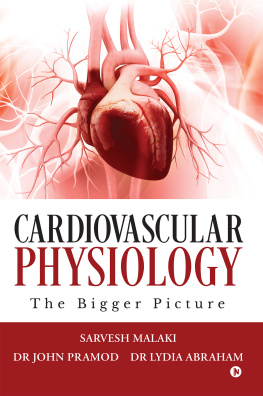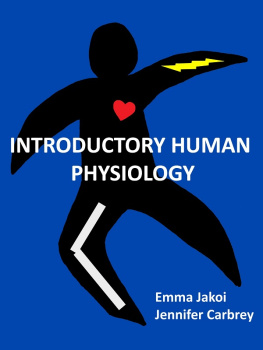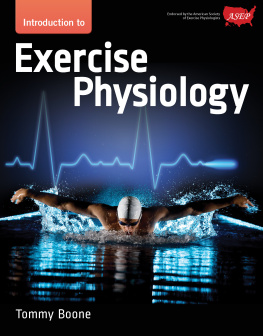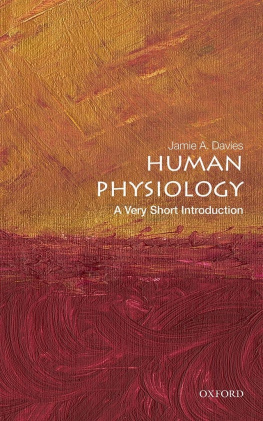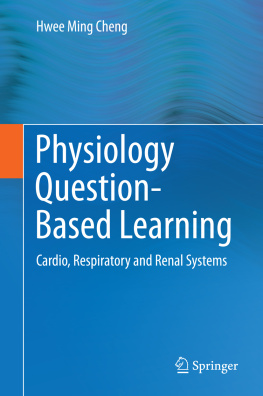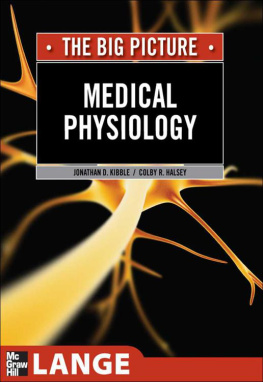Levick - An Introduction to Cardiovascular Physiology
Here you can read online Levick - An Introduction to Cardiovascular Physiology full text of the book (entire story) in english for free. Download pdf and epub, get meaning, cover and reviews about this ebook. year: 1991, publisher: Elsevier Science, genre: Romance novel. Description of the work, (preface) as well as reviews are available. Best literature library LitArk.com created for fans of good reading and offers a wide selection of genres:
Romance novel
Science fiction
Adventure
Detective
Science
History
Home and family
Prose
Art
Politics
Computer
Non-fiction
Religion
Business
Children
Humor
Choose a favorite category and find really read worthwhile books. Enjoy immersion in the world of imagination, feel the emotions of the characters or learn something new for yourself, make an fascinating discovery.

- Book:An Introduction to Cardiovascular Physiology
- Author:
- Publisher:Elsevier Science
- Genre:
- Year:1991
- Rating:4 / 5
- Favourites:Add to favourites
- Your mark:
- 80
- 1
- 2
- 3
- 4
- 5
An Introduction to Cardiovascular Physiology: summary, description and annotation
We offer to read an annotation, description, summary or preface (depends on what the author of the book "An Introduction to Cardiovascular Physiology" wrote himself). If you haven't found the necessary information about the book — write in the comments, we will try to find it.
Levick: author's other books
Who wrote An Introduction to Cardiovascular Physiology? Find out the surname, the name of the author of the book and a list of all author's works by series.
An Introduction to Cardiovascular Physiology — read online for free the complete book (whole text) full work
Below is the text of the book, divided by pages. System saving the place of the last page read, allows you to conveniently read the book "An Introduction to Cardiovascular Physiology" online for free, without having to search again every time where you left off. Put a bookmark, and you can go to the page where you finished reading at any time.
Font size:
Interval:
Bookmark:
J. R. Levick, MA, DPhil, BM, BCh
Reader in Physiology, St Georges Hospital Medical School, London
Butterworths
 PART OF REED INTERNATIONAL P.L.C.
PART OF REED INTERNATIONAL P.L.C.
All rights reserved. No part of this publication may be reproduced in any material form (including photocopying or storing it in any medium by electronic means and whether or not transiently or incidentally to some other use of this publication) without the written permission of the copyright owner except in accordance with the provisions of the Copyright, Designs and Patents Act 1988 or under the terms of a licence issued by the Copyright Licensing Agency Ltd, 3334 Alfred Place, London, England WC1E 7DP. Applications for the copyright owners written permission to reproduce any part of this publication should be addressed to the Publishers.
Warning: The doing of an unauthorised act in relation to a copyright work may result in both a civil claim for damages and criminal prosecution.
This book is sold subject to the Standard Conditions of Sale of Net Books and may not be re-sold in the UK below the net price given by the Publishers in their current price list.
First published, 1991
Butterworth & Co (Publishers) Ltd, 1991
British Library Cataloguing in Publication Data
Levick, J. R.
An introduction to cardiovascular physiology.
1. Man. Cardiovascular system. Physiology
I. Title
612.1
ISBN 0-750-61028-X
Library of Congress Cataloging-in-Publication Data
Levick, J. R. (J. Rodney)
An introduction to cardiovascular physiology/J.R. Levick.
p. cm.
Includes bibliographical references.
Includes index.
ISBN 0-750-61028-X :
1. Cardiovascular systemPhysiology. I. Title.
[DNLM: 1. Cardiovascular Systemphysiology. WG 102 L664i]
QP101.L471990
612.1dc20
DNLM/DLC
for Library of Congress90-1811
CIP
Composition by Genesis Typesetting, Laser Quay, Rochester, Kent
Printed and bound in Great Britain by Alden Press (London & Northampton) Ltd, London, England
This is an introductory text designed primarily for students of medicine and physiology. The teaching style is necessarily didactic in many places (The way it works is like this, ) but also, where space permits, I have tried to show how our knowledge of the circulation is derived from experimental observations. The latter not only puts flesh on the didactic bones, but ultimately keep the student (and the writer) in contact with reality. Human data are presented where possible, and their relevance to human disease is emphasized. The occasional anecdotes and doggerel betray a deplorable levity on my part, but will have earned their place if they interest the reader, and doubly so if they help to make a point memorable. The undergraduate will find a useful guide to learning objectives in the coloured box at the beginning of each chapter.
The traditional weighting of subject matter has been re-thought, resulting in a fuller account of microvascular physiology than is usual. This reflects the explosion of microvascular research over the past two decad-des. Even setting aside these advances, it seems self-evident that the culminating, fundamental function of the cardiovascular system the transfer of nutrients from plasma to the tissue merits more than the few lines usually accorded to it in introductory texts. Major advances continue apace in other fields too, for example the elucidation of the biochemical events underlying Starlings law of the heart, the discovery of new vasoactive substances produced by endothelium, the exploration of non-adrenergic, non-cholinergic neurotransmission, rapid advances in vascular smooth muscle physiology, and new concepts on how the central nervous control of the circulation is organized.
I would like to thank many friends and colleagues Tom Bolton, John Gamble, Max Lab, William Large, Janice Marshall, Charles Michel, Mark Noble, Peter Simkin, Laurence Smaje, Mike Spyer and John Widdicombe for helpful comments on sections of the text. Any mistakes or muddles that remain are, of course, entirely my own; please do not hesitate to point them out to me. Perhaps I should thank the cardiovascular system too, for proving to be even more fascinating than I had realized before writing this book!
Rodney Levick, St. Georges Hospital Medical School
This chapter provides an overview of the cardiovascular system. The rate at which diffusional transport occurs is critically important because the supply of nutrients must keep up with cellular demand. The first and foremost function of cardiovascular system is the rapid convection of oxygen, glucose, amino acids, fatty acids, vitamins, drugs, and water to the tissues and the rapid washout of metabolic waste products like carbon dioxide, urea, and creatinine. The cardiac output is the volume of blood ejected by one ventricle during one minute, and this depends on both the volume ejected per contraction (the stroke volume) and the number of contractions per minute (heart rate). The behavior of the heart and the blood vessels has to be regulated to deal with varying environmental and internal stresses.
The heart and blood vessels form a system for the rapid transport of oxygen, nutrients, waste products and heat around the body. Small primitive organisms lack such a system because their needs can be met by direct diffusion from the environment, and even in man diffusion remains the fundamental transport process between blood and cells. In order to appreciate fully the need for a cardiovascular system we must begin by considering some properties of the diffusion process.
illustrates how this happens. Notice that although the net transfer of solute is from compartment A into compartment B there is also a smaller backflux into compartment A. This can be proved by adding a trace of radiolabeled solute to compartment B; some labelled molecules appear in compartment A even though the net diffusion is from A to B.

Figure 1.1 Sketch illustrating how random molecular steps result in a net movement of solute down a concentration gradient. At time 1 (upper sketch) there are 8 molecules per unit volume in (A) and 2 in (B). At time 2 (lower sketch) each molecule has moved a unit step in a random direction. Because there was a greater density of molecules in A there was a greater probability of random movement from A to B, resulting in a net downhill flux
The rate at which diffusional transport occurs is critically important because the supply of nutrients must keep up with cellular demand. However, as Albert Einstein showed the time (t) that it takes a randomly jumping particle to move a distance x in one specific direction increases with the square of distance:
 (1.1)
(1.1)
is an example of this: it shows the heart of a patient who suffered a coronary thrombosis (obstruction of the blood supply to the heart wall). The pale area in the wall is muscle which has died from lack of oxygen even though the adjacent cavity (the left ventricle) was fully of richly oxygenated blood; the patient died simply because a distance of a few millimetres reduced diffusional transport to an inadequate rate.
Font size:
Interval:
Bookmark:
Similar books «An Introduction to Cardiovascular Physiology»
Look at similar books to An Introduction to Cardiovascular Physiology. We have selected literature similar in name and meaning in the hope of providing readers with more options to find new, interesting, not yet read works.
Discussion, reviews of the book An Introduction to Cardiovascular Physiology and just readers' own opinions. Leave your comments, write what you think about the work, its meaning or the main characters. Specify what exactly you liked and what you didn't like, and why you think so.

